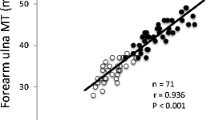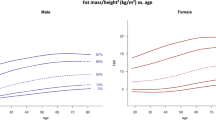Abstract
Background & Objectives
Currently, only one study has used dual-energy X-ray absorptiometry (DXA)-derived percent body fat (BF%) as the criterion measure to develop ultrasound prediction equations to estimate BF% in adults between the ages of 50 and 80 years. The aim of this study was to examine the relationship between BF% estimated from subcutaneous fat thickness using a previously published Japanese-based prediction equation and DXA-derived BF% in Caucasian middle-aged and older adults. A secondary aim was to develop a new prediction equation for Caucasian adults if the previously published equation did not predict BF% well in Caucasians.
Design
Cross-sectional study.
Participants & Measurements
One-hundred and two Caucasian adults aged 50–76 years (59 men and 43 women) had ultrasound fat thickness and DXA values measured. A new BF% prediction model was developed using ordinary least squares multiple linear regression.
Results
There was a strong correlation between ultrasound predicted and DXA-derived BF% (r = 0.882, p<0.001). Bland-Altman analysis did not indicate a bias in the prediction of BF% for Caucasian adults (r = −0.092, p>0.05). However, the predicted BF% was significantly higher compared to DXA-derived BF% (approximately 4%). A newly developed nonlinear prediction model used to estimate BF% was significant [F(17,84) = 33.44, p<0.001] with an R2 of 0.871 and an adjusted R2 of 0.845. When examining the stability of the model, bootstrapping (n=1000) resulted in an optimism value of 0.1135 so that the corrected R2 was 0.758. After removing an outlier, the model was significant [F(17,83) = 34.82, p<0.001] and it’s R2 was 0.877 and adjusted R2 was 0.852.
Conclusion
The developed equation was stable with a high degree of variance compared to results from previous studies. The results of this study also suggest that ethnicity should be considered when choosing which prediction equations should be used to estimate BF%.



Similar content being viewed by others
References
Finelli C, Sommella L, Gioia S, La Sala N, Tarantino G. Should visceral fat be reduced to increase longevity? Aging Res Rev 2013;12:996–1004.
Patel TP, Rawal K, Bagchi AK, et al. Insulin resistance: an additional risk factor in the pathogenesis of cardiovascular disease in type 2 diabetes. Heart Fail Rev 2016;21:11–23.
Ellis KJ. Human body composition: in vivo methods. Physiol Rev 2000;80:649–680.
Kyle UG, Bosaeus I, De Lorenzo AD, et al. Bioelectrical impedance analysis — part I: review of principles and methods. Clin Nutr 2004;23:1226–1243.
Muller W, Horn M, Furhapter-Rieger A, et al. Body composition in sport: interobserver reliability of a novel ultrasound measure of subcutaneous fat tissue. Br J Sports Med 2013;47:1036–1043.
Abe T, Loenneke JP, Thiebaud RS. The use of ultrasound for the estimation of muscle mass: one site fits most? J Cachexia Sarcopenia Muscle 2018;9:213–214.
Buckner SL, Abe T, Counts BR, Dankel SJ, Barnett BE, Loenneke JP. Muscle and fat mapping of the trunk: A case study. J Ultrasound 2015;18:399–405.
Thiebaud RS, Abe T, Loenneke JP, Fijita E, Akamine T. Body fat percentage assessment by ultrasound subcutaneous fat thickness measurements in middle-aged and older adults. Clin Nutr [published online ahead of print November 30, 2018]. https://doi.org/10.1016/j.clnu.2018.11.017
Kadowaki T, Sekikawa A, Murata K, et al. Japanese men have large areas of visceral adipose tissue than Caucasian men in the same levels of waist circumference in a population-based study. Int J Obes (Lond) 2006;30:1163–1165.
Park YW, Allison DB, Heymsfield SB, Gallagher D. Large amounts of visceral adipose tissue in Asian Americans. Obes Res 2001;9:381–387.
Abe T, Thiebaud RS, Loenneke JP, Young KC. Prediction and validation of DXA-derived appendicular lean soft tissue mass by ultrasound in older adults. Age (Dordr) 2015;37:114.
Abe T, Kondo M, Kawakami Y, Fukunaga T. Prediction equations for body composition of Japanese adults by B-mode ultrasound. Am J Hum Biol 1994;6:161–170.
Bland JM, Altman DG. Statistical methods for assessing agreement between two methods of clinical measurement. Lancet 1986;i:307–310.
Harrell FE Jr. Regression modeling strategies with applications to linear models, logistic regression, and survival analysis. 2015. Springer.
R Core Team. R: A language and environment for statistical computing. R Foundation for Statistical Computing. 2018. Vienna, Austria. URL https://doi.org/www.R-project.org/
Ishida Y, Kanehisa H, Kondo M, et al. Body fat and muscle thickness in Japanese and Caucasian females. Am J Hum Biol 1994;6:711–718.
Leahy S, Toomey C, McCreesh K, O’Neill C, Jakeman P. Ultrasound measurement of subcutaneous adipose tissue thickness accurately predicts total and segmental body fat of young adults. Ultrasound Med Biol 2012;38:28–34.
Hyde PN, Kendall KL, Fairman CM, Coker NA, Yarbrough ME, Rossi SJ. Use of B-Mode Ultrasound as a Body Fat Estimate in Collegiate Football Players. J Strength Cond Res 2016;30:3525–3530.
Saito K, Nakaji S, Umeda T, Shimoyama T, Sugawara K, Yamamoto Y. Development of predictive equations for body density of sumo wrestlers using B-mode ultrasound for the determination of subcutaneous fat thickness. Br J Sports Med 2003;37:144–148.
Author information
Authors and Affiliations
Corresponding author
Rights and permissions
About this article
Cite this article
Abe, T., Loenneke, J.P. & Thiebaud, R.S. An Ultrasound Prediction Equation to Estimate DXA-Derived Body Fatness for Middle-Aged and Older Caucasian Adults. J Frailty Aging 8, 79–84 (2019). https://doi.org/10.14283/jfa.2019.8
Received:
Accepted:
Published:
Issue Date:
DOI: https://doi.org/10.14283/jfa.2019.8




